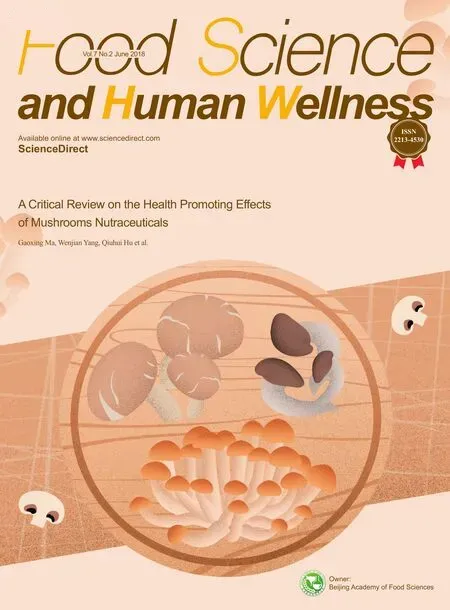Development of a reversed dispersive based graphene functionalized with multiwalled carbon nanotubes for detection of β2-agonists in pork by high-performance liquid chromatography
Ying-Wen Qian,Xia Hong,Cai-Xia Yuan,*,Xin-Kui Zhou,Hai-Ning He,Dong-Shuai Wang
a Quality and Safety Technological Innovation Service Platform on Circulation of Animal Origin,Gansu Institute of Business and Technology,Lanzhou,Gansu 730010,China
b Key Laboratory of Animal Products Safety Analysis and Detection Technology of Gansu Province,Lanzhou,Gansu 730010,China
ABSTRACT A reliable and inexpensive pretreatment procedure in the determination of β2-agonists in pork was developped.The procedure used a nanocomposite of multiwalled carbon nanotubes (CNTs) functionalized with graphene (rGO) as the reversed dispersive sorbent.It was analyzed after purification by highperformance liquid chromatography,the extraction time and the properties of the nanocomposite were optimized.Under optimized conditions,present method has linear response over concentration range of 0.5-50 ng/mL in pork samples with a satisfactory detection limit close to 0.1 ng/mL.The precisions of the current method (coefficient of variation) are lower than 5%,while recoveries are more than 98.3%.The nanocomposite exhibited high adsorptivity,long-term storage stability,satisfactory anti-interfering activity and high selectivity toward β2-agonists compared with those of rGO and CNTs.
Keywords:High-performance liquid chromatography Graphene Multiwalled carbon nanotube Ractopamine Salbutamol
1.Introduction
Ractopamine and salbutamol are β2-agonists used in the treatment of pulmonary disease and asthma [1,2].They can promote animal growth,increase accretion of skeletal muscle mass,and decrease deposition of body fat [3-5].However,they are illegally applied as nutrient-repartitioning agents in livestock to greatly improve the production of muscle tissues[6,7].Therefore,a selective,simple,and sensitive method for determining β2-agonists in food samples is required to evaluate the risks associated with their consumption[8].
Recent studies have developed many analytical methods for the determination of β2-agonists in biological products.These methods include high-performance liquid chromatography (HPLC) [9],gas chromatography mass spectrometry [10]and liquid chromatography mass spectrometry [11].Among these methods,HPLC is considered to be one of the most promising analytical techniques because ofits simplicity,low cost,extremely high accuracy and time-saving derivatization procedures[12,13].
A complex pretreatment procedure including organic-solvent extraction and solid-phase extraction after enzymatic hydrolysis is used in most of the well-established methods[14].Thus,effective pretreatment of β2-agonists still remains a challenge,as both hamper the detection of β2-agonists in fresh meat [15,16].Therefore,a simple,rapid,affordable,and reliable pretreatment for quantitative determination of β2-agonists in meat samples still needs to be explored[17].
Carbon nanomaterials such as multiwalled carbon nanotubes(CNTs)and reduced graphene oxide(rGO)can strongly adsorb hydrophobic organic contaminants because of their very high surface hydrophobicity.In addition,compounds bearing πelectrons are capable ofinteracting with hybrid nanocomposites via π-π electron coupling [18,19].Thus,hybrid nanocomposites can be suitable for the removal of organic contaminants [20].CNTs/rGO mixtures exhibit strongly anisotropic thermal,electrical transport properties and extremely low out-of-plane conductivities [21,22].Multiwalled CNTs and rGO-Nafion composites have recently been used to modify glassy carbon electrodes to detect β2-agonists [23,24].Recently,some groups have also reported the usage of CNTs-rGO nanocomposites was used in reversed dispersive-solid-phase extraction (dSPE) to determine pesticides and veterinary drugs.The method has high recovery due to its efficient adsorption [25-27].Compared with other adsorption materials,such as C18column and molecularly imprinted polymers,CNTs-rGO nanocomposites typically showed superior adsorptivity because of their large active surface area.They also had diverse physical and chemical functionalities due to their surface modification[28].
In this paper,an efficient and reliable pretreatment based on CNTs-rGO nanocomposite for the detection of β2-agonists in meat was described.The nanocomposite multi-walled carbon nanotubes exploit the special physical and chemical characteristics of a carbon-based nanomaterial,which include unique thermal,mechanical,electronic and chemical properties [29,30]; thus conferring them excellent adsorption ability.Furthermore,the protocol for preparing the nanocomposite is simple,environmentfriendly,fast and controllable[31].Due to the speed and simplicity of the pretreatment,the development of high-throughput methods using the nanocomposite as dSPE material is feasible[32].We tested the proposed material on their sensitivity,accuracy,reproducibility and stability to ensure the material is a suitable adsorbent for β2-agonists.
2.Materials and methods
2.1.Materials and reagents
Ractopamine and salbutamol were purchased from Dr.Ehrenstorfer (Darmstadt,Germany).HPLC-grade methanol,HPLC-grade formic acid,and pristine multiwalled CNTs (1-2 μm length,20-40 nm diameter) were purchased from Shenzhen Nanotech Port Co.Ltd.,China.Reduced graphene oxide (99.99%,0.45 μm average particle size; SP-1,Bay Carbon),sodium nitrate (NaNO3,98%),potassium permanganate (KMnO4,99.5%),poly(dimethyldiallyl ammonium chloride),(PDDA,99.6%),concentrated sulfuric acid (H2SO4,98%),formic acid,methanol (99.3%),1,3,6,8-pyrenetetrasulfonic acid sodium salt(PyTS,98%)were used.Hydrated hydrazine(99%)was purchased from Sigma-Aldrich(St.Loius,MO,USA),and water was purified through a Milli-Q reverseosmosis system(Millipore,Milford,MA,USA).
2.2.Chromatographic conditions
HPLC with fluorescence detection (Shimadzu,20A,Jap.) was used for the simultaneous determination of β2-agonists in fresh meat.Separation was carried out on an Acquity BEH C18column(50 mm×2.1 mm,1.7 μm) maintained at 30°C.The mobile phase consisted of solvents A(0.1%formic acid in water)and B(methanol).The initial condition was 5% B held for 1.5 min.After 30 min,the amount of B was linearly increased to 55%.At 4.0 min,the gradient was programmed to initial conditions to equilibrate the column for 2.0 min(10 min total run time).The flow rate was 1.0 mL/min,and the injection volume was 10 μL.Injection was done in full-loop mode.
2.3.Preparation of CNTs noncovalently functionalized with PDDA
Multiwalled CNTs were purified by refluxing in diluted H2SO4/HCl(1:3,v/v)solution for 10 h.Pristine CNTs(50 mg)were immersed in 25 mL of ethanol solution for 1 h,and then PDDA(20 mg) was added.The mixture was stirred for 4 h under a N2atmosphere[14].Finally,it was centrifuged and washed three times with ethanol.The final product was dried in a vacuum oven at room temperature for 8 h.
2.4.Preparation of PyTS-functionalized rGO
PyTS could markedly improve the solubility and dispersibility of rGO in aqueous solution [16,17].Thus,rGO was functionalized with PyTS via π-π stacking to facilitate its dispersion in aqueous solution.Initially,1 mg of rGO was added to water(10 mL),and then sonicated for 1 h.Secondly,10 mL of PyTS was added to the rGO dispersion solution,which was then stirred at 75°C for 24 h.The final solid product was obtained by centrifugation and filtration.
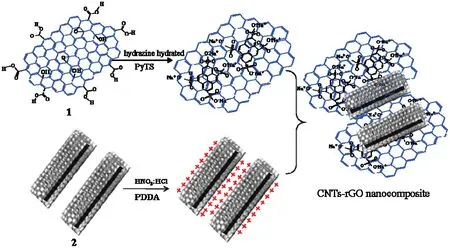
Scheme1.the mechanism of formation of the CNTs-rGO nanocomposite.
2.5.Preparation of CNT-rGO nanocomposites
For the synthesis of CNTs-rGO nanocomposites (CNTs/rGO ratios of 25:75,50:50 and 75:25,w/w),about 1 g of each mixture of functionalized CNTs and functionalized rGO at the required proportions(1:3,1:1,and 3:1)was ultrasonicated in deionized water for 30 min and then magnetically stirred for 24 h.The final product was dried in a vacuum oven at room temperature for 8 h.
2.6.Sample pretreatment
The sample for testing was rapidly homogenized and then stored at 20°C and at 4°C before being thawed prior to use.Synthesis was briefly outlined as follows:Pork (5 g) was added to 80 μL of 5 ng/mL internal standard solution(ractopamine and salbutamol).The sample was transferred to a tube that was activated with 10 mL methanol followed by 10 mL of water.The tube was washed with 5 mL of water and methanol,and then the pH of the mixture was adjusted to 3.5.Afterwards,3 mg of CNTs-rGO nanocomposite was added,and the sample was shaken for 4 h to reach equilibrium.The suspension was then centrifuged at 10,000 rpm for 5 min.The supernatant was discarded,and 5 mL of water/methanol(9:1,v/v)solution containing 2% formic acid was added to the tube.The tube was then vortexed for 3 min and centrifuged at 10,000 rpm for 3 min.The supernatant was filtered through a Nylon membrane(Jinteny,Tianjin,China) and then directly injected into the HPLC system to determine the β2-agonists.
2.7.Method validation
To verify the absence ofinterfering substance around the retention time of the analyte,25 blank samples of fresh meat were analyzed.The suitability of the method for the determination of ractopamine and salbutamol in pork was evaluated according to the European Commission Decision 2002/657/EC[19,20].

Fig.1.TEM images of (A) rGO and (B) CNTs-rGO nanocomposite; (C) XRD pattern of the CNTs-rGO nanocomposite; (D) UV-vis absorption spectrum of the CNTs-rGO nanocomposite.
3.Results and discussion
3.1.Characterization of the nanocomposite
Syntheses of functionalized rGO and functionalized CNTs to form the three-dimensional (3D) nanocomposite are shown in Scheme 1.Positively charged CNTs have strong electrostatic interaction with PDDA and negatively charged rGO,forming the rGO-based nanostructure with CNTs uniformly incorporated between rGO nanosheets.rGO and CNTs comprise a nanosupport with large active surface area,high conductivity,as well as diverse physical and chemical functionalities due to surface modification[33].The large active surface area may be due to the presence of CNTs between the rGO layers,which effectively prevent the latter from restacking.
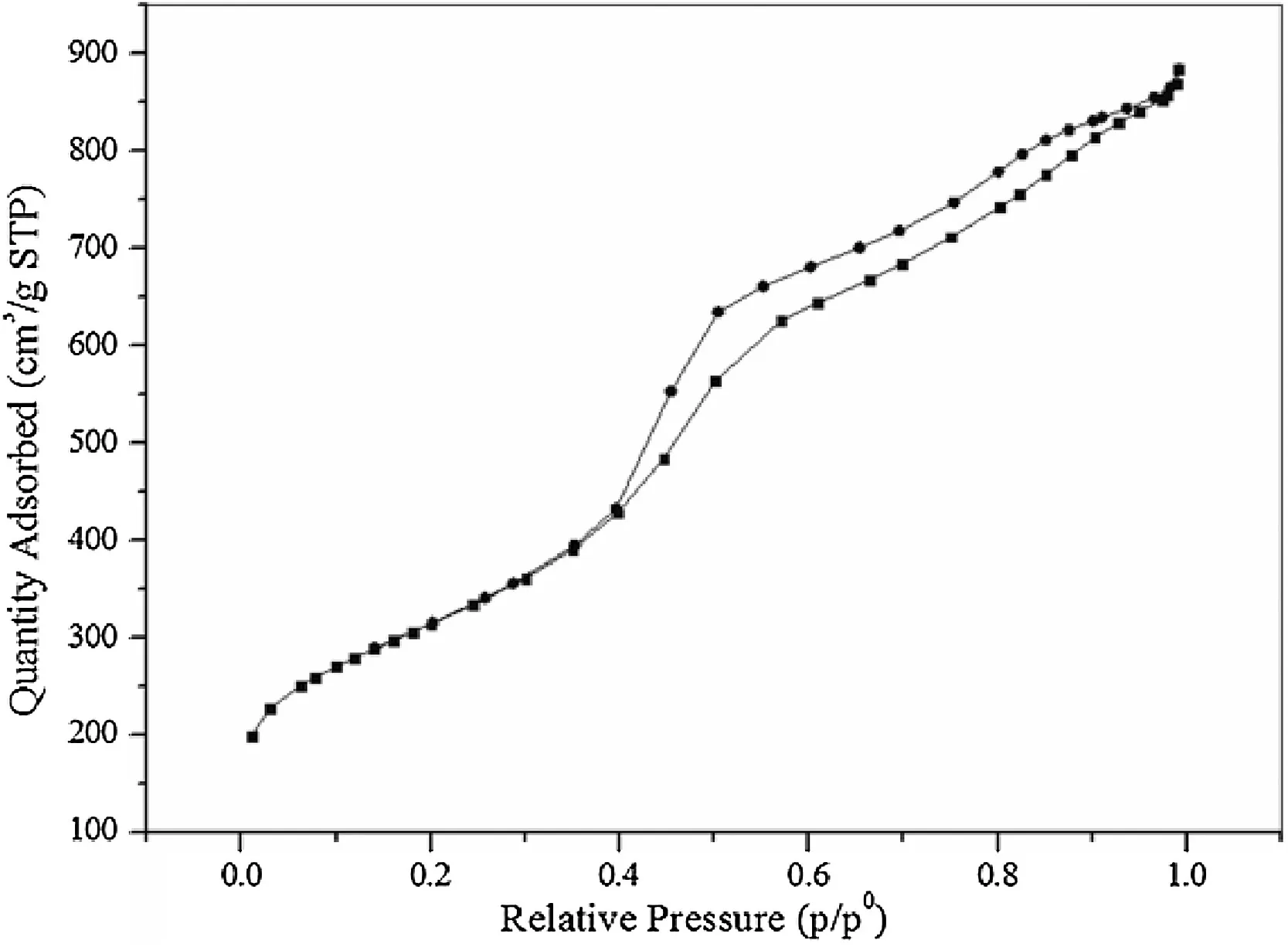
Fig.2.Nitrogen adsorption stripping curve of CNTs-rGO nanocomposite.
Fig.1A and B shows transmission electron microscopy (TEM)images of the rGO nanosheet and CNTs-rGO nanocomposite respectively.Each rGO nanosheet was rippled and overlapped with other sheets.Fig.1B shows that reduced graphene oxide nanosheets enabled dispersion of functionalized CNTs in aqueous solution.There were no CNT bundles or large agglomerates;as only small particles were present on the rGO surface,the CNTs uniformly dispersed in GO in the nanohybrid.Notably,binder-free CNTs-rGO remained intact after the reduction of GO,probably because of the strong interaction between rGO nanosheets and CNTs.The X-ray diffraction (XRD) pattern and ultraviolet-visible (UV-vis) absorption spectrum of the as-obtained CNTs-rGO nanocomposite are respectively shown in Fig.1C and D.There are two absorption features in the UV-vis absorption spectrum:a peak at 268 nm due to the π-π* transition of C=C and a shoulder at about 300 nm corresponding to the n-π*transition of the C=O bond[23,24].
Further information about the adsorption properties of carbon nanocomposite was obtained by nitrogen adsorption-desorption is otherm which is shown in Fig.2.The N2adsorption isotherm of mesoporous carbon nanocomposite shows a rapid up take at low relative pressure(P/P0>0.9)band typical of type I adsorption behavior.
3.2.HPLC detection of β2-agonists using CNTs-rGO nanocomposite as adsorbent
Because of the loss resulting from adsorption,we used two isotope-labeled internal standards (ractopamine and salbutamol)to correct the quantitative results (Fig.3).Chromatogram 1 was desorbed at the first time.We obtained 98.6%,97.9%,and 93.6%of the signals for the initial peak heights.Curve 2 was desorbed at the second time,and 3.8%,2.2%,and 8.2% peak height signals were obtained.These results suggest that the adsorbed material became refined completely for the first time and that the CNTs-rGO nanocomposite could strongly adsorb hydrophobic organic contaminants because ofits very high surface hydrophobicity.
The linearity of the method was determined by constructing calibration curves from different concentrations of two β2-agonists and by using the corresponding isotope internal standards at a fixed concentration (Fig.4).Standard solutions with 0.5-50 ng/mL concentrations of salbutamol,ractopamine,and ractopamine/salbutamol mixture(Fig.4C)were prepared by dilution of blank solutions of the sample extracts at appropriate concentrations.All studies used HPLC.The method exhibited a good linear response over the selected concentrations for each compound.The correlation coefficient(R2)for each calibration curve is 0.9968,and the calculated detection limit atS/N=3 is 0.1 ng/mL.These imply the high adsorptivity of the CNTs-rGO nanocomposite toward the β2-agonists.The results also suggest that the CNTs modify rGO by altering their surface property and preventing their possible agglomeration,in addition to acting as a linkage between rGO and the analytes.Therefore,rGO nanosheets enable dispersion of CNTs in aqueous solution[27].

Fig.3.HPLC chromatograms of β2-agonists adsorbed on the CNTs-rGO nanocomposite.
3.3.Effect of the extraction time
The effect of the extraction time on the recovery of agonists from fresh meat at different shaking times (1,2,3,5,and 10 min)was investigated by using 3 mg of CNTs-rGO nanocomposite at pH 3.5.The sample concentration was 50 ng/mL.As expected,the extraction recoveries increased with extraction time.However,an extraction time greater than 5 min did not substantially enhance the extraction efficiency (Fig.5).Similarly,it found that adsorption of nitroaromatic compounds onto carbon nanocomposite isa fast process.Therefore,3 min extraction time was used in our subsequent experiments.
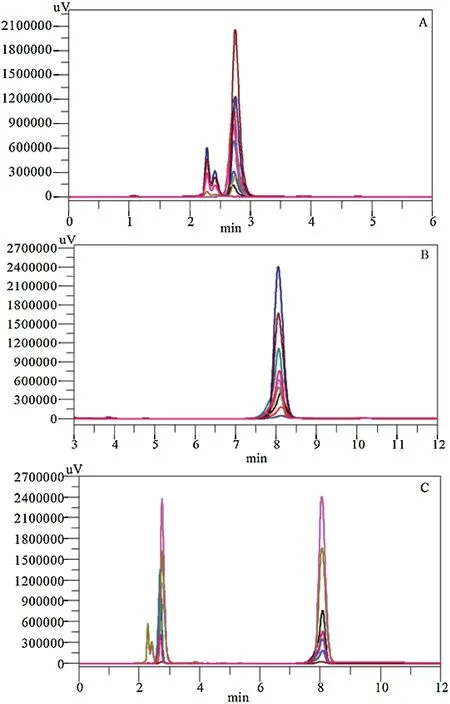
Fig.4.HPLC chromatograms of CNTs-rGO nanocomposites to different concentrations of β2-agonists adsorption behavior.
3.4.Comparison of various nanocomposite responses
Ractopamine and salbutamol were used as representative β2-agonists to study the adsorption ability during solid-phase extraction using the CNTs-rGO nanocomposite.The adsorption of ractopamine and salbutamol on CNTs-rGO,rGO,and CNTs(a,b,and c represent CNTs-rGO nanocomposite,rGO,and CNTs respectively) was investigated by HPLC using 50 ng/mL solutions(results are shown in Fig.6).Compared with rGO and CNTs,CNTs-rGO nanocomposite produced more intense peaks that are proportional to ractopamine and salbutamol concentrations.These results indicate that the CNTs-rGO nanomaterial adsorbs nitroaromatic compounds applications more strongly than do rGO and CNTs.
In a further investigation,a 1:1 CNTs/rGO mixture was used as adsorbent for β2-agonist detection because ofits good adsorptivity (results are shown in Fig.7; a,b,and c represent 1:1,1:3,and 3:1 (v/v) CNTs/rGO ratios).This result may be attributed to the exfoliation of rGO sheets and high accessibility of the surface area.The uniform dispersion of rGO and CNTs (1:1,v/v) allows a more efficient utilization and higher surface area,thus increasing the availability of triple phase boundary,which is very important for β2-agonists.The CNTs help prevent the restacking of rGO nanosheets and hence provide more surface area for the adsorption of ractopamine and salbutamol.

Fig.5.The extraction time of β2-agonists by CNTs-rGO nanocomposites.
3.5.Stability and anti-interfering activity
The adsorption stability of β2-agonists on the CNTs-rGO nanocomposite was evaluated.Each sample was stored at 4°C for one week.We obtained 96.5%,96.2%,and 93.2%of the initial peak height signal after one-week storage; 93.8%,94.2%,and 92.1% of the peak height signal remained,indicating that the prepared production has good long-term stability.The reproducibility of this adsorbing material was also investigated.The relative standard deviations (RSDs) of the sensor response to 50 ng/mL β2-agonist were 3.26%,3.12%,and 3.06%for 14 successive measurements.Six samples from the same synthetic procedure were prepared and used for the determination of β2-agonists in solution.The resulting RSDs were 3.6%,3.1%,and 3.2%.These results indicate that adsorption by and fabrication of the nanomaterial is reproducible.Interference of some common inorganic ions and organic compounds was also evaluated.The influence of various substances on the determination of 50 ng/mL β2-agonists was studied by HPLC.We found that 20-fold addition ofp-nitrophenylmethane,pyrocatechol,chlorodinitrobenzene,and 800-fold addition of Ca2+,Mg2+,Na+,K+,NH4+,Cu2+,Zn2+,F-,Cl-,Br-,NO3-,and SO42-did notinterfere with the determination.The tolerance limit was estimated to be <5% of the relative error.This indicates that the proposed method is robust toward interferences.
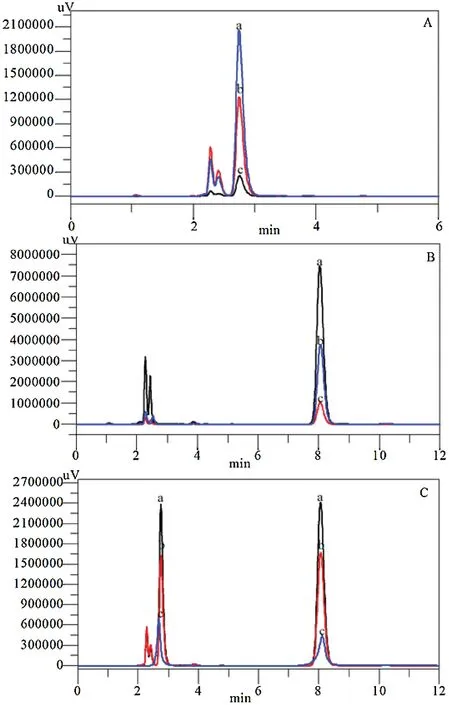
Fig.6.The adsorption behavior of β2-agonists by three different adsorbent materials.
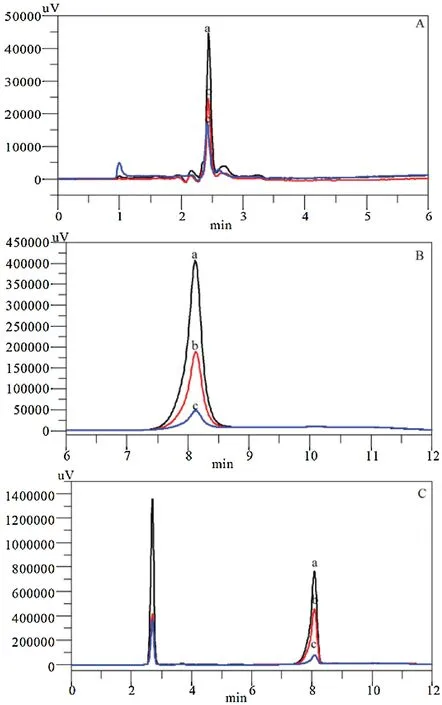
Fig.7.HPLC chromatograms for β2-agonists adsorbed on CNTs-rGO nanocomposites with different proportions of multiwalled CNTs and graphene.
3.6.Preliminary analysis of real samples
In order to investigate the practicability of the CNTs-rGO nanocomposite,it was used in the analysis oflow levels of β2-agonists in fresh meat (mutton,beef and chicken).The method of standard addition was used to detect the β2-agonists in these samples.Samples spiked with standard were analyzed.Table1 showed that the method is accurate and sensitive.Therefore,we believe that it may be used for other fresh meat samples.

Table1 CNTs-rGO nanocomposites for different concentrations of β2-agonists maximum adsorption capacity(n=5).
4.Conclusions
In summary,the multi-walled carbon nanotubes functionalized with graphene nanocomposite has been prepared via a facile and versatile hydrothermal synthetic strategy.The positively charged CNTs functionalized with PDDA and negatively charged rGO to create a strong electrostatic interaction,forming a graphene-based nanostructure with CNTs uniformly incorporated between rGO sheets.Under optimized conditions,present method has linear response over concentration range of 0.5-50 ng/mL in pork samples with a satisfactory detection limit close to 0.1 ng/mL.The precisions of the current method(coefficient of variation)are lower than 5%,while recoveries are more than 98.3%.The results showed that CNTs-rGO nanocomposite exhibited an excellent adsorption per-formance,good sensitivity,reproducibility,long-term stability and satisfactory anti-interference ability.
Conflict ofinterests
The authors declare that there is no financial conflict ofinterests to publish these results.
Acknowledgements
This study was financially supported by the Program of Technology Gansu Province(1309RTSA025,1009FTGA018,1306TTPA036).
- 食品科学与人类健康(英文)的其它文章
- Protein quality of four indigenous edible insect species in Nigeria
- Identification of sea snake meat adulteration in meat products using PCR-RFLP of mitochondrial DNA
- Glycoalkaloids and phenolic compounds in three commercial potato cultivars grown in Hebei,China
- Volatile components,total phenolic compounds,and antioxidant capacities of worm-infected Gomphidius rutilus
- Chicken collagen hydrolysates differentially mediate anti-inflammatory activity and type I collagen synthesis on human dermal fibroblasts
- Anticancer effect of curcumin on breast cancer and stem cells

